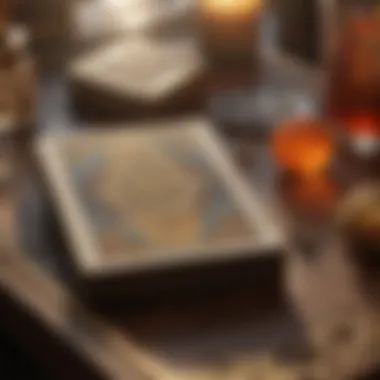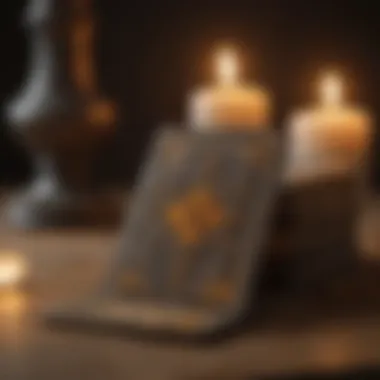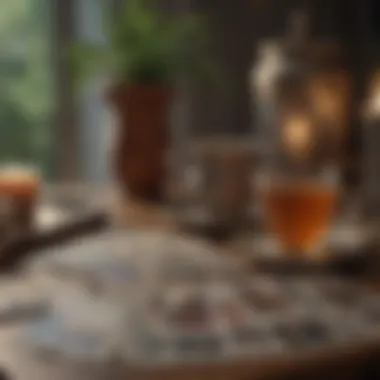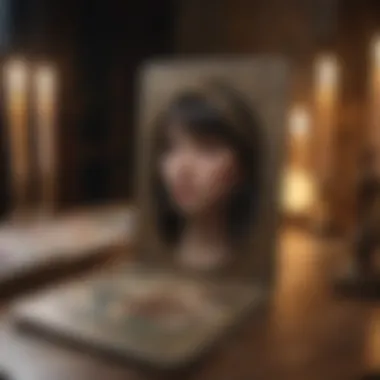Crafting Effective Questions for Tarot Readings


Intro
The art of crafting meaningful questions for tarot readings is essential for both beginners and seasoned practitioners. The questions you ask shape the interpretation of the reading, guiding the energy and focus of the cards. It is vital to approach this task with a clear mind and intentionality.
Questions in tarot can unlock profound insights. They can reveal intimate truths about love, career, and personal growth. The process of formulating effective inquiries requires a blend of intuition and strategy, ensuring that the questions resonate with the querent's needs and desires.
Throughout this article, we will explore various techniques for constructing tarot questions. We will also discuss the significance of clarity in inquiry and how different types of questions can lead to diverse interpretations.
Let's begin our journey into tailoring the questions that will enhance tarot practice.
Preface to Tarot Questions
The process of formulating questions for tarot readings serves as the cornerstone for effective inquiry. In exploration of tarot, the quality of the questions posed can dramatically influence the outcomes and insights gained from the cards. Questions guide the reading, providing a framework through which the wisdom of the tarot can unfold.
When engaging with tarot, it is essential to recognize how each question shapes the narrative of the reading. Questions act not only as a means of steering the interpretation of the cards, but also as a pathway to deeper self-reflection. Through thoughtful questioning, practitioners can explore personal challenges, gain clarity about relationships, or delve into their spiritual journey.
Here are a few key elements to consider when approaching tarot questions:
- Direction: Questions should have a clear focus, directing attention toward specific areas of concern or curiosity.
- Depth: Effective questions invite nuance and complexity, encouraging a thorough exploration rather than simple yes or no answers.
- Intention: Each question should carry a purpose, reflecting the inquirer’s desire to gain insight and understanding.
By understanding the importance of questions within tarot practice, users can harness the full potential of their readings. This guide will delve deeper into the nuances of question formulation, emphasizing clarity and intention. An informed approach can lead to more meaningful connections with the tarot, enhancing both personal and collective experiences.
Understanding the Role of Questions in Tarot
In tarot readings, questions serve as the essential bridge between the reader and the cards. They enable the practitioner to focus their energy and intention. Each question acts like a thread, weaving a narrative that connects personal experiences with the wisdom of the tarot.
Questions can also reveal the underlying motivations and desires of an individual. By framing inquiries properly, one can peel back layers of consciousness, opening avenues for introspection and growth. Rather than being mere words, these questions become tools for discovery, transforming the tarot from a mere divination practice into a more profound journey of self-exploration.
Key aspects of the role of questions in tarot include:
- Guidance: Questions help pinpoint the areas requiring insight, be it emotional complexities or career decisions.
- Clarity: Clear questions provide sharpness of focus, making the reading experience more productive.
- Connection: Good questions establish a strong connection between the reader and the querent, fostering trust and understanding.
"The right question can change everything, shifting your perspective toward new possibilities."
In summary, embracing the role of questions in tarot combines structure and intuition, bringing valuable insights and revelations to the forefront. This understanding paves the way for more enriched readings and empowered practitioners.
The Importance of Clarity
Clarity is a crucial element in formulating questions for tarot readings. A well-crafted question lays the foundation for the entire reading. This section will emphasize why clarity in inquiry is essential and how it influences both the questions posed and the resultant insights gleaned from the cards.
Why Clear Questions Matter
When it comes to tarot, clear questions create a focused environment for interpretation. Ambiguity can lead to confusion, often resulting in overly broad or irrelevant readings. Each question should be a targeted inquiry that directs attention toward a specific area of life or concern. For instance, instead of asking, "What does my future hold?" a clearer version would be, "How can I improve my relationship with my partner?"
Clear questions not only guide the tarot reading but also help the querent understand their own desires and motivations. By articulating a specific query, individuals are encouraged to reflect deeper on their situations. Engaging with the query thoroughly allows for a more meaningful dialogue between the cards and the person seeking insight.
Impact on the Reading Process
The impact of clarity extends beyond just the formulation of questions. It influences the overall flow of the tarot reading. When questions are specific and well-structured, the reader can draw connections between the cards more easily. This focused approach minimizes the risk of misinterpretation. A clear question can lead to a straightforward reading, illuminating the querent's path in a way that feels relevant and actionable.
Moreover, clarity can enhance the querent's engagement during the reading process. When individuals understand exactly what they are asking, they are more likely to resonate with the insights provided. It creates an environment where the interpretation can unfold organically. This mutual understanding helps foster a richer dialogue between the tarot and the querent.
"The quality of inquiry determines the depth of insight that will be revealed in the reading."


In consideration of these factors, clarity in tarot questions is not merely a guideline; it is a practice that elevates the entire reading experience. Tarologists and aspiring tarot practitioners should prioritize clear inquiry, as it sets the stage for more meaningful and impactful readings.
Crafting Effective Questions
Crafting effective questions is a fundamental skill in tarot reading. The ability to ask well-formulated questions can significantly impact the outcomes of the readings. When the questions are precise and directed, they guide the tarot card interpretations towards relevant insights. This section focuses on the techniques to create such questions and examines common pitfalls to avoid.
Techniques for Formulating Questions
Using Open-Ended Questions
Open-ended questions are essential tools in tarot inquiry. Unlike closed questions that restrict answers to ‘yes’ or ‘no’, open-ended questions invite expansive responses. An example could be, "What should I focus on in my career right now?" This phrasing encourages a richer dialogue with the cards. The key characteristic of open-ended questions is their ability to promote exploration. They are popular because they elicit deeper insights and reflections. While they are beneficial for detailing situations, they can sometimes lead to a lack of focus if not guided properly.
Incorporating Specificity
Incorporating specificity is crucial for creating impactful questions. A specific question narrows down the focus. For instance, instead of asking, "What is my future?" one might ask, "What opportunities will arise in my career over the next six months?" This specificity opens the door to tailored interpretations. The key characteristic of this approach is its directness. Specific questions eliminate ambiguity and direct the reading toward defined areas. However, overly specific inquiries may limit visibility to broader insights.
Focusing on Intent
Focusing on intent refers to aligning the question with a clear purpose or desire. An example of this could be, "How can I improve my relationship with my partner?" This inquiry reflects an intention to address a specific relational dynamic. The key characteristic here is awareness of one’s motivation behind the question. This focus encourages readings that resonate deeply with the querent's true needs and aspirations. Nevertheless, being overly rigid in intent can prevent the exploration of unexpected insights.
Common Pitfalls to Avoid
Vague Questions
Vague questions can muddle the reading process. A question like, "What about my life?" lacks clarity and can lead to confusion. The key characteristic of vague questions is their ambiguity. They often generate unfocused responses that do not provide useful insights. Avoiding vagueness is crucial, as it often leads to a diluted connection with the cards.
Leading Questions
Leading questions suggest a particular answer and can bias the reading. For example, asking, "Why is my boss treating me poorly?" implies that there is a definite negative treatment. The key characteristic of leading questions is their directive nature. They lend themselves to interpretations that may not genuinely reflect the querent's situation. This may distort the reading, making it essential to remain neutral in phrasing.
Overly Broad Inquiries
Overly broad inquiries can overwhelm the reading. A question such as, "What will happen in my life?" encompasses too much ground. The key characteristic of broad inquiries is their lack of direction. Such questions lead to scattered insights rather than focused guidance. To ensure efficacy, it is best to narrow inquiries to specific areas of interest.
Types of Questions for Tarot Readings
Understanding the various types of questions that can be posed during tarot readings is crucial. Each category serves distinct purposes and can change the depth and nature of the insights derived from the cards. By grasping the different types, a reader can better tailor their inquiries to suit their specific needs or areas of interest.
Personal Insight Questions
Personal insight questions are aimed at self-reflection and understanding one's own thoughts, feelings, and motivations. These questions help to explore the inner workings of the self. By asking questions such as "What do I need to learn from this situation?" or "How can I overcome my fears?", the querent engages with their own psyche. This approach promotes introspection and can lead to meaningful discoveries about one's personal journey.
These inquiries work well in guiding the reader toward actionable insights that they can implement in their lives. The clarity of the question typically leads to more revealing interpretations from the cards, which can resonate deeply. Moreover, personal insight questions often evolve over time, reflecting changes in the querent’s life.
Relationship Dynamics Questions
Questions about relationship dynamics are essential in addressing the complexities between individuals. For example, inquiries like "What is the current state of my relationship?" or "How can I improve communication with my partner?" can present clear information.
These types of questions allow the tarot to shed light on interactions, emotions, and potential outcomes within relationships. They can help identify patterns and challenges, guiding the querent to understand the dynamics at play. Moreover, these inquiries can also offer perspective on relationships with family, friends, or colleagues, broadening the scope of understanding interpersonal connections.
Career and Financial Questions
Career and financial questions establish aims and clarifications about one’s professional life. They might include questions like "Am I on the right career path?" or "What can I do to increase my financial security?" Such inquiries help uncover underlying issues or opportunities regarding career choices or financial situations.


By focusing on career, the querent can use tarot as a tool for strategic planning. Understanding potential outcomes and obstacles not only aid in decision-making but also foster a sense of empowerment to pursue desired career objectives. In this context, tarot readings serve as a source of guidance that can steer individuals towards making informed decisions about their future.
Spiritual Growth Questions
Spiritual growth questions facilitate exploration of deeper existential themes. Questions such as "What lessons am I meant to learn in this life?" or "How can I strengthen my spiritual practice?" invite profound insights into one's spiritual journey. These inquiries often encourage the querent to confront their beliefs and values, fostering a connection with higher self-awareness.
Through spiritual growth inquiries, tarot readings can illuminate paths toward enlightenment and understanding. They help establish intention and serve as a roadmap for pursuing spiritual development. With the right questions, a querent can merge their personal experiences with the wisdom of the cards, leading to a richer understanding of their spiritual self.
Examples of Effective Questions
Crafting effective questions for tarot readings is crucial. The right inquiries lead to insights that can guide personal growth, inform decisions, and deepen spiritual understanding. This section explores examples of effective questions across diverse areas of life. These queries are designed to elicit meaningful responses from the tarot. They highlight intent and clarity, allowing the reader to connect more profoundly with the cards.
Personal Growth Examples
Questions focusing on personal growth should encourage self-reflection. They often center on understanding oneself better. Here are some examples:
- What are the patterns in my life that I need to address?
- How can I take greater responsibility for my choices?
- What steps can I take to enhance my self-esteem?
Each of these questions pushes the individual to look inward and examines their behaviors and choices.
Interpersonal Relationship Examples
Inquiries about relationships can reveal dynamics that may not be obvious. Such questions facilitate understanding and communication. Consider these examples:
- What can I do to improve communication with my partner?
- How does my friendship influence my personal growth?
- What unresolved issues should I address in my family relationships?
These questions encourage the querent to explore their relationships and understand their impact on their life.
Financial Queries Examples
When it comes to finances, asking the right questions can provide clarity on decisions. Here are useful examples:
- What financial patterns should I be aware of?
- How can I create stability in my financial life?
- What steps should I take to achieve my career goals?
These questions help clarify one's situation and provide guidance on financial health.
Spiritual Insight Examples
Questions aimed at spiritual insight can enhance a person's journey. They often encourage exploration of beliefs and values. Examples include:
- What do I need to learn on my spiritual path?
- How can I align my actions with my spiritual beliefs?
- What practices can deepen my connection to my intuition?
These inquiries promote deeper connection with one's spiritual self and help identify areas for growth.
Crafting good questions leads to richer tarot readings and helps in understanding the subtleties of life.
Intention-Setting Before a Reading
Setting intentions prior to a tarot reading is a critical practice to enhance both the experience and the outcomes of the reading. The process of intention-setting helps focus the mind and energy, aligning the reader with their purpose. This foundational step can lead to more meaningful insights and a greater understanding of the messages that emerge from the cards. Moreover, it creates an atmosphere of reverence and mindfulness, essential for absorbing the significance of each reading.
When intentions are set clearly, they can guide the reading process in a positive way. It is not simply about asking questions; it is about preparing oneself mentally and emotionally to receive the answers. The intentions need to resonate personally with the reader or querent. They serve as an anchor, helping to clarify what is sought from the reading. By fostering this clarity, readers can expect a more enriched tarot experience, making the insights derived from the cards more impactful.
Creating a Sacred Space


The concept of a sacred space is integral to the practice of tarot reading. This dedicated area should be free from distractions and negative energies. It is essential to establish an environment that feels safe and inviting. To create a sacred space, one can consider using calming elements such as soft lighting, comfortable seating, and perhaps some personal items that invoke positive feelings or memories.
Involving sensory elements can significantly enrich this experience. Utilizing incense or essential oils can bring about a serene atmosphere, while calming music can help create a tranquil soundscape. Engaging with tactile accessories, like crystals or natural elements, can help foster a deeper connection to the energies at play.
Many practitioners also find that integrating personal rituals enhances their readings. Simple actions, like lighting a candle or arranging the tarot cards in a particular way, can serve as symbolic gestures that invite focus and intention.
Meditation Techniques
Meditation serves as a powerful technique for intention-setting before a tarot reading. This practice can clear the mind and open the heart, allowing for deeper self-reflection. A few different methods can be employed, each promoting a state of calm conducive to effective tarot work.
- Breath Awareness: Focusing on the breath can help ground one’s energy. Take deep, slow breaths, counting each inhale and exhale. This method can alleviate anxiety and center thoughts.
- Visualization: Engage in guided visualization where one imagines their desired outcomes or questions. Visualizing success or clarity can amplify the intentions for the reading.
- Body Scan: A body scan can help connect with physical sensations, releasing tension that may obstruct mental clarity. By becoming aware of each part of the body, readers can become more attuned to their feelings and the energies around them.
Incorporating these meditation techniques allows the reader to tune into their inner guidance. This state of openness is essential for any inquiry posed to the tarot, ensuring both clarity and receptivity to the insights that the cards may reveal.
"By setting intentions and creating a conducive environment, tarot readers can profoundly enhance their practice."
Fostering an engaged space for contemplation and preparation enriches the overall tarot experience, leading to more insightful and transformative readings.
Processing Insights from the Cards
Understanding how to process insights from tarot readings is essential for anyone looking to deepen their practice. Each card drawn carries specific meanings and symbolisms that can provide answers and guidance. The interpretation of these meanings can vary depending on the context of the question and the individual's personal intuition. Therefore, a focus on processing these insights allows for greater clarity and relevance in the reading.
Evaluating Card Meanings
To effectively process insights from tarot cards, evaluation of their meanings is critical. Each tarot card has established interpretations, but these meanings can shift based on surrounding cards and the specific question asked. Card meanings often derive from various sources including traditional symbolism and contemporary interpretations. This evaluation can be done by:
- Studying the symbolism: Each card has distinct imagery that conveys its essence. Observing colors, figures, and objects depicted can offer additional insights.
- Understanding associations: Knowing whether the card is considered Major or Minor Arcana impacts its significance. For example, Major Arcana cards often point towards significant life themes, while Minor Arcana cards can represent everyday experiences.
- Utilizing guides: Many practitioners keep reference books or online resources to continually refine their understanding of each card. Engaging with multiple sources can produce a richer interpretation.
It is important to note how the card relates to the question at hand, as meanings may shift with context. For example, the Three of Cups generally indicates celebration and friendship, but in a reading focused on a career question, it may suggest collaboration rather than pure joy.
Reflecting on Personal Relevance
After evaluating the meanings of the cards, reflection on personal relevance is crucial. This step involves examining how the insights provided by the cards apply to one’s own life. Continuous reflection ensures that the reading resonates on a personal level and drives meaningful interpretation.
When reflecting on personal relevance, consider these aspects:
- Identifying emotions: Pay attention to feelings evoked during the reading. Emotional responses can offer clues to the cards' impact on your life.
- Considering life circumstances: Relate the card's insights to current situations or challenges. Drawing connections can enhance the overall understanding of the reading.
- Journaling thoughts: Keeping a record of readings and personal reflections can illuminate patterns over time. This practice enables tracking personal growth and how insights have evolved.
Closing Thoughts on Tarot Questions
Formulating the right questions is an essential element in tarot reading. It shapes the direction of the reading and influences the depth of insights gained. This section underscores the significant role of inquiry in tarot practice. By grasping the nuances of how questions can be formulated, readers can enhance not just their readings but also their understanding of their own life paths.
The Evolving Nature of Inquiry
Inquiry in the realm of tarot is not static; it evolves as the reader deepens their practice and insights. Early questions may focus on immediate concerns, such as personal challenges or relationship dynamics. However, as a practitioner becomes more attuned to the cards and their interpretations, questions may shift toward broader themes such as purpose, spiritual growth, and universal truths. This evolution reflects a higher level of understanding and engagement with the tarot. In asking profound, layered questions, the tarot reader cultivates a more enriching dialogue with the cards.
A deeper inquiry often leads to layers of meaning within the tarot cards, revealing more than just responses to surface-level concerns.
The process of evolving inquiry involves a continual reassessment of one's objectives. Practitioners are encouraged not to shy away from asking difficult or uncomfortable questions. Instead, such inquiries can facilitate transformative insights and profound self-discovery. This level of depth is valuable, as it acknowledges the complexities of life, allowing for a greater degree of personal growth.
Encouragement for Further Exploration
As practitioners conclude their readings or reflections on questions posed, there is a compelling invitation to delve further into the art of inquiry. Continuous exploration is vital not only for personal growth but also for enhancing the tarot reading experience. Engaging with resources, such as books, online forums, and workshops, offers new perspectives and methodologies. These platforms can be beneficial for refining the skills to craft better questions and interpret the cards more effectively.
Practitioners should also consider their intentions beyond the immediate reading.
- Think about how these insights can inform future actions.
- Reflect on how expanding the scope of questions could lead to richer readings.
- Experiment with different styles of questioning.
Overall, the act of questioning in tarot should be viewed as a journey. A commitment to ongoing inquiries and explorations allows practitioners to deepen their connection with the cards and their own intuition. As the tarot reader's experience grows, so too will the quality of questions, ultimately leading to even more meaningful insights.







